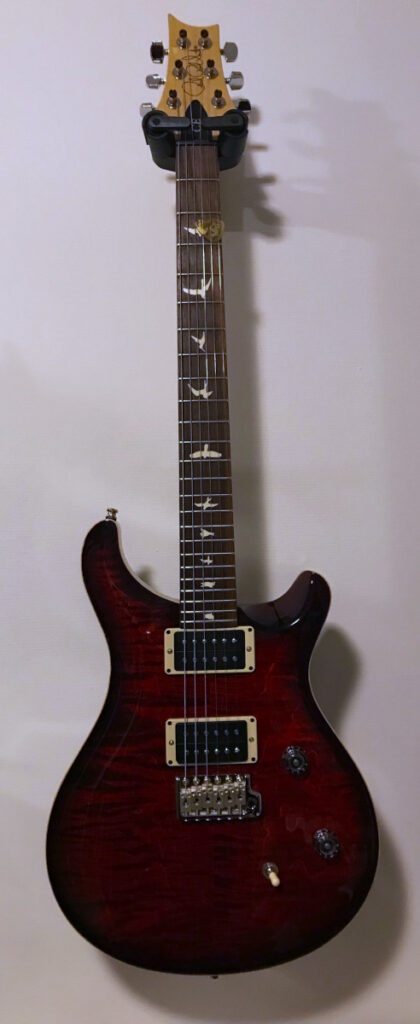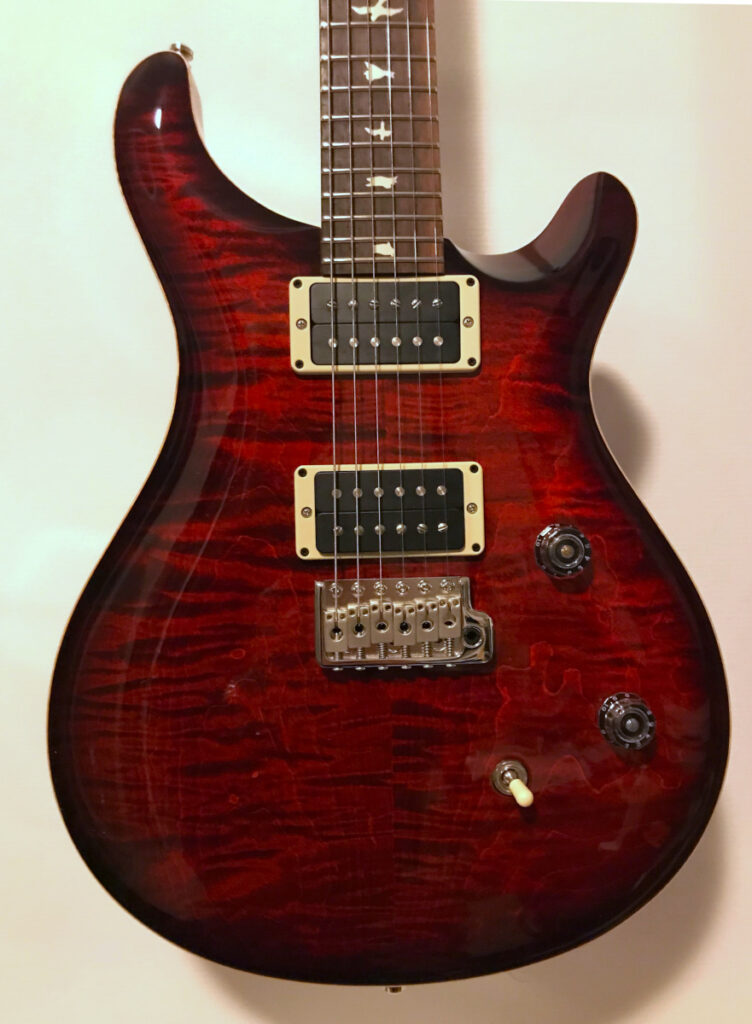I recently got to visit Guitarking in Boekel, the store where I got my Les Paul. It’s a really nice guitar store with a good assortment of higher-priced gear. As I’ve developed an interest in Superstrats, that’s what I wanted to try.
I started out with an Ibanez AZ 2402 Prestige (from the Japanese-made range). The most noticeable about this model was the neck. Very slick playing roasted maple, I’d consider the neck shape more of a U than a C, which required some getting used to. The stainless steel frets were awesome, super smooth with perfectly rounded fret edges. The pickups (Seymour Duncan Hyperion) are good all-round humbuckers. The coil-tap switch only had limited effect on the sound. A really good guitar, I just wish there was more color choice – and the neck profile is not my favorite. I also tried an AZ2204 (22 frets, HSS), which was of the same quality.
I also tried an RG, the RG562AHMFX Prestige to be precise, a dual-humbucker hardtail model. This model has the Ibanez Wizard neck, a thin D-shape that is great for shredding up high, but felt really weird for me when playing chords. The pickups were more scooped, clearly aimed at high gain. The quality was also great, but I would not be able to bond with this neck shape.
There were plenty of HSS Stratocasters on offer, but I wanted to stick to HH models. So my next try was a PRS SE Custom 24. I’ve read good things about these guitars. I’ve tried an SE 245 many years ago (back then they were made in Korea), but some years ago PRS moved construction of these to Cort in Indonesia. The setup on this one was as good if not better than on the Ibanez Prestige’s, with great fretwork as well. PRS reportedly runs all SE models through QC in their US factory (at least for US-market models) before sending them to dealers, and it shows. Probably the only giveaway that this is a cheaper model was the pickup selector switch which was a bit wobbly. The finish was nice and it sounded a bit warmer than the Ibanez AZ models. The neck (Wide Thin) is a C-shape, not dissimilar to the modern C on my MIM Standard Stratocaster.
Unfortunately, they also stocked a few CE 24 models. This is the bolt-on version of the Custom 24 and resides between the set-neck core models and the S2 models in the PRS range. Here’s a short overview of the PRS model range:
- SE are the entry-level models built in Indonesia, including hardware and pickups built there. Non-locking tuners. The top has a simpler beveled shape with a flat center.
- S2 are the most affordable US-made models, but with the hardware and pickups from the SEs. Locking tuners. The S2 Custom 24 also has a flat center and beveled edges. The bird inlays are off-white plastic.
- The bolt-on range made in the USA. The Silver Sky is probably the most popular model, but the CE (essentially a bolt-on neck Custom 24) has been available for many years. Pickups are US-made, hardware is the same as on the S2, and the birds are also white plastic. The top is solid two-piece maple (no veneer) and has a shallow violin carve.
- The core range are the full-featured US models. The difference between core Custom 24 and a CE 24 is in (except for bolt-on vs. set neck) a machined instead of molded vibrato, different tuners, and true Abalone bird inlays. Rear cavity covers are recessed, and I think that the violin carve is a bit deeper. These also come with a case instead of a gig bag.
This means that the differences between the CE 24 and a core Custom 24 are quite small. The most important difference between the SE Custom 24 and the CE 24 was in the neck – not so much in the neck profile (Wide Thin vs. Pattern Thin), but in the finish (gloss vs. smooth satin) and the fretboard edges. The CE 24 had rolled fretboard edges that were even more comfortable to play. My wife wanted to gift me the guitar that I really wanted. I had to think about this for a bit because a) the CE 24 was quite a bit more expensive than the SE Custom 24 and b) I wasn’t sure whether I would prefer Blue Matteo as color above the Fire Red Burst this guitar was in. I eventually decided that the differences in playability and overall build were worth the price difference, and that the Fire Red Burst with its dark edges and nice contrast to the fake binding was the better looking finish. This guitar also had a very nice top with curvy lines that I haven’t seen before on a flame maple top. So I got to take it home. I’m extremely happy with this guitar, it is very versatile with excellent build quality and setup, and it’s a beauty, too!

